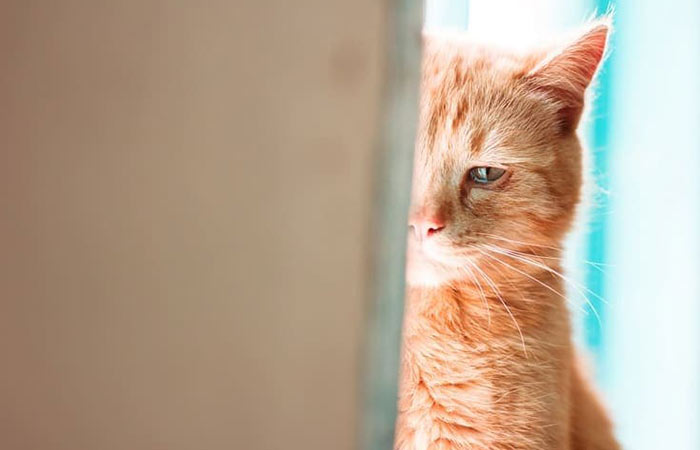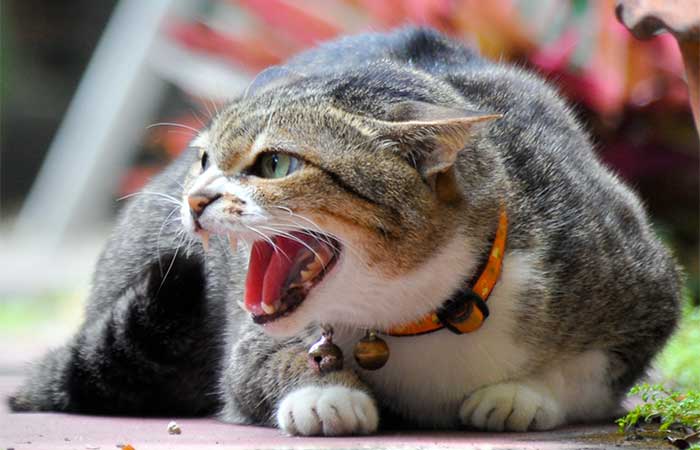Feelings, some of which are instinctive and some of which we learn from those around us as we conform to societal expectations and norms. Human emotions range from "primitive" emotions such as disgust, anger, fear and desire, to "complex" emotions such as compassion and jealousy.
Recent research, particularly in fields such as neuropsychology, suggests that more "primitive" or basic emotions have a physiological basis and may be elicited by chemical stimuli or visual stimuli. Basic emotions appear to cause chemical changes in the body in response to stimuli.
This article explores feline emotion. In places, it compares or contrasts human and feline responses or, for illustration, compares them to other animals.

01 Two very different views
Do cats (compared to other higher animals) have feelings? Can they respond emotionally? According to many pet owners the answer is "yes." Cats can show a range of emotions, including happiness, frustration, and affection. While certain other behaviors may be attributed to jealousy, frustration, or even revenge.
The owner's answer is based on their observation of the cat's behavior, but if they do not understand the characteristics of the cat, they may attribute emotions that the cat does not feel and will not be able to identify the true cat's emotions.
If owners are too biased towards the "Does my kitty miss her mother?" approach, they may not understand (or want to accept) that cat emotions have evolved to adapt to situations that are very different from ours.
Cats and humans are basically built the same, with many common senses -- sight, hearing, smell, taste, touch -- and some additional "senses" that are adaptations to our particular environment and lifestyle.
Although humans have better vision, cats have better smell, taste, and hearing. Like us, cats can sense heat, cold, pain and other physical sensations. Physical stimuli may lead to physiological responses, some of which are referred to as emotions.
If humans and cats have similar reactions to, for example, the smell of a tempting food, they may share certain emotions, such as pleasure at the prospect of a satisfying meal.
However, according to many scientists, the answer is "no."
They believe that humans like to anthropomorphize (assign human qualities to non-human animals) and see pets as surrogate children. We interpret our pets' instinctive behavior based on our own broad range of emotions. We would credit them with feelings that they do not otherwise have.
It is true that some scientists deny that animals (including cats and dogs) are merely flesh-and-blood "machines" set up for survival and reproduction. Certain pet behaviorists, believe that animals have some degree of emotional response and a limited range of emotions (compared to humans).
Many researchers have a more sinister motive for their skepticism. Those who deny that animals have any emotions may be trying to justify what others consider inhumane animal experimentation. This denial of animal emotion allows them to conduct experiments with little regard for the physical or mental health of their subjects. The denial of animal emotion is their own rhetoric, not a conclusion based on behavioral research.
Some religions teach that humans are superior to animals and, by extension, that animals do not have emotions. Some cultures do not recognize animals as thinking, feeling entities. Politicians and those who oppose "animal rights" argue that giving animals emotions would give them rights (possibly equal to those of humans), which would change the entire human-animal relationship, making pet ownership, agriculture, hunting, and experimentation unacceptable. They believe that humans would be reduced to animals, which would mean: hunting, forced sterilization, selective breeding, etc.
Are all these polarizing views correct, or do cats also have certain emotions, perhaps a limited subset of the emotions we feel? To find the answer, we must observe our own and our cats' reactions to situations and analyze what emotions are.

02 Emotional Brain
Charles Darwin concluded that animals do have emotions. He went on to explore the degree of animal emotion and found that there is a continuum of emotion and cognition between humans and animals, that is, there is not a huge gap between animals, but a continuum ranging from unintelligent, unemotional "primitive" creatures to highly emotional and intelligent humans. Where there are gaps, these are differences in degree, not differences in the kinds of emotion.
Although Darwin gave animals different degrees of emotion, many scientists have avoided the issue of animal emotion by putting quotation marks around words like "nervous" or "fearful". This suggests that animals behave as if they have these emotions, but they do not actually have them, so the attribution of emotions is an anthropomorphic act of the scientific observer, hence the quotation marks.
To understand emotions, scientists have studied how emotions are formed and how they relate to the rest of the body and the external world. To do this, they have studied how the brain works, usually by studying how individual brain cells are linked together, how they interact with each other, and by studying what happens when parts of the brain are damaged, either deliberately or accidentally.
The brain contains neurons (nerve cells) that communicate through synapses. Communication takes the form of electrical impulses from one end of the nerve cell to the other, and chemicals at the synapses between the nerve cells. By measuring the levels of electrical impulses and certain chemicals, and by interfering with these, the researchers investigated the way the brain works. Electrodes placed in certain locations in the brain can be used to trigger specific emotions. A part of the amygdala is continuously stimulated to induce terror, which eventually leads to the animal's death.
These methods are invasive and stressful for the animals (which end up permanently damaged during the experiment or killed when they are no longer needed) - no wonder scientists believe that animals cannot feel happiness. Even after death, an animal's brain can be dissected or sectioned and stained under a microscope to see if certain emotions (such as prolonged terror) cause permanent changes in the brain. Other methods study how the brain works as a whole, looking at it in action, rather than dissecting the dead brain. Brain waves can be measured with electroencephalographs (EEG) and scalp electrodes; there are other techniques such as MRI scans (magnetic resonance imaging), CAT scans (computer-assisted tomography) and PET scans (positron emission tomography). Some of these can be used when a person or animal is in its natural environment.
Psychopharmacologists use drugs to study changes in animal behavior. Drugs are administered to test subjects to measure changes in behavior and mood. Rapid eye movement (REM) sleep is associated with information processing and emotion; chemicals that interfere with REM sleep can lead to increased irritability and anger (and eventually death). Not all tests are performed to study animal behavior/emotion -- sometimes it is found in tests where animals are used to simulate the effects of drugs on humans.
Behavioral geneticists selectively breed or transgenic animals to find out which genes are associated with which emotions, and how those genes (and their effects) are inherited and whether they can be manipulated. As a result, there are lab strains of mice that are laid back and mice that are nervous.
The same can be seen in cats - from the laid-back Ragdoll and the placid Persian to the "hyper" Siamese. Geneticists have further studied how emotions are affected when certain physical characteristics are altered. It has been shown that emotions involve the interaction of sensory organs, the nervous system and other parts of the body.
In experimental psychology, there are 3 main schools of thought about emotions. The categorical approach assumes that certain emotions (fear, joy, etc.) come from within the brain and can be measured by biological changes. The social constructivist approach is concerned with how animals use emotions to communicate or relate to other animals. The component approach considers emotions as consisting of reward and learning.
Research in such distant fields as ethology (behavioral research) and neurobiology supports the view that supports animal emotions. Even the most skeptical scientists agree that many organisms experience fear. This is because fear is considered to be a simple instinctive feeling that does not require conscious thought. Fear is hardwired into the brain and is critical to fleeing predators and responding to other threats. Fear underlies the fight or flight response, as evidenced by the fact that some young birds freeze at the sight of a hawk-shaped silhouette overhead, but not at the sight of a dove-shaped silhouette, even if they have never seen a real hawk. Fear also raises heart rate and blood pressure.
Fear is innate and does not require conscious thought, but the existence of more complex animal emotions involving mental processing is more difficult to demonstrate. Because complex emotions are intangible and difficult to study under laboratory conditions, many researchers consider the field of studying emotions to be unrewarding. Modern, media-friendly ("How the brain works!") neuroscience and neuropsychology disciplines have changed this. Scientists also recognize the importance of field observations, as long as they are carefully and fairly documented and sufficient observations are made.
One of the most obvious animal emotions is happiness. This is evident when your cat snuggles and purrs and when he plays. While playing is an important part of learning and honing life skills for adolescents, it is also clearly fun in a way that adult cats would not otherwise bother to play. There is evidence that playing, or at least the physical exertion aspect of playing, releases "feel good" hormones in the brain that give a sense of well-being. When rats play, their brains release dopamine, a neurochemical associated with pleasure and euphoria. When rats look forward to a play session, dopamine is released, making them active, vocal and excited (this effect can be seen by giving rats a dopamine blocker). Happy rats also produce opiates, which are another feel-good neurochemical.
Grief following the death of a mate, parent, offspring, or pack mate has also been observed in many wild species. Feline grief at the death of a human or feline long-term partner may include severe psychiatric disturbances. Grief varies from individual to individual, with some cats showing little to no grief while others may be severely traumatized. This variability has led some scientists to insist that observation of cat grief is anthropomorphic behavior on the part of the owner. These scientists forget or ignore the fact that humans are equally variable in the way they express grief.
In humans, the hormone oxytocin, is associated with sexual activity and maternal bonding. Experiments with monogamous prairie voles have shown that it affects attachment between animals. Injections of oxytocin trigger mate choice in female prairie voles, while blocking oxytocin prevents these females from choosing a mate at all. Oxytocin causes prairie voles to "fall in love" (or more accurately, "fall in love").
Thus, emotion accompanies biochemical changes in the brain. Fear accompanies the production of brain chemicals that lead to alertness and readiness to flee; pleasure triggers the release of "feel-good" brain chemicals. Chronically produced stress hormones can damage the hippocampus (the central part of the brain for learning and memory),** and experiments have shown that stressed-out mothers have more problems producing healthy offspring. **Other emotions are biologically less clear-cut; for example, "shame" and "embarrassment" are "social emotions" -- the result of attaching emotional meaning to unacceptable or inappropriate behavior, respectively. While emotions such as fear and pleasure are common in both humans and animals, researchers cannot agree on how much of a role social emotions play in non-human animals.
The limbic system is the part of the brain associated with many emotions; experiments have shown that it becomes active when animals or people are frustrated, and damage to this region produces aggressive impulsive behavior.
From an evolutionary perspective, the limbic system is an ancient part of the brain that is not unique to humans: animals have emotions, but only humans rationalize these emotions and agonize over their feelings.
The amygdala, an amygdala-like structure located in the center of the brain, is closely associated with fear. Brain imaging studies on humans have shown that the amygdala is activated when a person experiences fear. Stimulating a part of the amygdala with electrodes induces an intense state of fear. Animals with a damaged amygdala, including ourselves, do not show a normal response to danger and seem unable to feel fear when placed in a dangerous situation. The amygdala is also implicated in other emotions.
The question of whether an animal has emotions is often confused with whether the animal is conscious. Although cats have some self-awareness, they are not conscious in the same way that humans are. Even when cats know there is no cat in the mirror, they will play with the reflection in the mirror. However, cats do not recognize the image in the mirror as themselves. **Human language also confuses the issue of "emotion" and "consciousness"; when we talk about our feelings, it is often unclear whether we are referring to our emotional state or our sense of self.

03 In the laboratory and in the field
Laboratory animals behave differently than animals in the wild (or home) environment. They have different environments. They also interact very differently with other animals and with humans. Laboratory animals may have little opportunity for social contact with others, or their responses may be influenced by experimentation or genetics. Some animals are selectively bred for specific traits, and they may not exhibit "typical" or representative behaviors.
Emotions cannot exist in a vacuum; they are (in part) a response to external factors. Many laboratory animals exhibit aberrant behaviors (e.g., self-mutilation, fecal eating) due to their sterile environment. These are all manifestations of stress and depression, but are often not referred to as such for the reasons mentioned earlier. It is recognized that animals are distressed in these conditions, for example, animals in some of the worst zoos exhibit behavioral/emotional problems: repetitive pacing/shaking and psychological problems.
Animals are responsive to their environment. It is impossible to accurately assess the normal psychological responses of a creature that is treated as an emotionless biological machine and kept in an unstimulating or highly dysfunctional environment. This is just as dangerous as anthropomorphizing animals in a cute way. Animal welfare activists are often accused of inappropriately ascribing emotion to animals. Acknowledging the emotions of animals can cause problems for experimental laboratories because they do not want to make improvements to the environment that houses disposable living "tools" at a really "high cost.
Scientists in animal experiments believe that animals are not fully capable of suffering because they cannot anticipate future events. While cats cannot predict irregular events or distant future events like we can, cats have a good sense of time and can predict regular and near-future events, such as their owners returning from work at similar times each day. Ironically, the cat's sense of time and ability to predict regular events (such as food being delivered) has been tested in laboratory experiments. Cats are similarly capable of anticipating unpleasant routine events, such as daily experimental procedures, and showing fear or aggression when approached by the experimenter.
Even in less invasive techniques, the scientific method does not like to have too many variables. Scientists prefer to measure one variable at a time. Unlike inanimate properties such as temperature or pressure, which can be controlled individually under laboratory conditions, emotions cannot be isolated. Environmental factors must be manipulated in order to produce changes in mood. Individuals may respond differently to the same environmental changes. This makes the study of emotions under laboratory conditions frustrating. Many scientists claim that it is impossible to prove that animals have emotions using standard scientific methods: reproducible observations that can be manipulated in controlled experiments. They therefore conclude that emotions in animals must not exist. This is a drawback of the scientific method. Due to the use of unnatural and invasive methods, many realised animals do not show typical emotions under laboratory conditions, yet no one denies that humans have emotions.
In order to properly assess animal emotions, scientists and animal behaviorists must study animals in the field or at home. The environment can be manipulated, but it cannot be absolutely controlled. What matters is how the animal behaves in its own environment and how it interacts with the environment and others. The observer must interpret the behavior and decide if the observed person is afraid, worried, angry, etc. To ensure consistency of approach, the animal's behavior can be categorized according to a short list of possible emotions or on a sliding scale of specific attributes, such as fear or curiosity. A similar approach has been used to assess the behavior of very young children.
Increasingly, farmers, recognize that animals need to express instinctive behaviors. Although some stress is inevitable in farming, animals under minimal stress are likely to be more productive, have better immune systems, be less prone to disease, and have lower mortality rates. This is more evident in zoos and wildlife parks, where environmental enrichment and encouragement of natural behaviors result in "happier" (less stressed) animals more likely to breed successfully in captivity.
Acknowledging that animals have emotions may go too far and can easily lead to misunderstandings. The human tendency to project human-like thoughts, motivations, and desires onto animals can lead to pets being treated as little furry people who should love and show us gratitude. While our cats may indeed love us and feel grateful (in the feline sense of love and gratitude), they may suffer the consequences of our unrealistic expectations because they do not show gratitude in the human sense or in sufficient amounts (based on the amount humans would show) -- they show gratitude by being happy cats rather than by pandering.
Pet cats have traits that humans find desirable: friendliness, playfulness, cuddliness, and dependability. These are preserved juvenile (kittenhood) traits, as wild and feral adult cats are by nature wary, independent and more solitary. Despite selective breeding for physical characteristics and friendliness to humans, cats behave like their wild ancestors, but they adapt their innate behaviors to fit the home environment.
Owners rely on the cat's behavior and body language to understand its emotional state. Dogs are considered to be more expressive than cats in this regard. Dogs have evolved elaborate social communication systems in groups; the human family is a surrogate group, so dogs communicate with their owners as they do with other dogs. Dogs transfer their dog-to-dog social behaviors to dog-to-human communication. Many dog owners misinterpret the submissive or juvenile behavior of lower ranking dogs (toward their higher ranking owners) as affectionate.
Cats are more solitary than dogs and have a looser social structure (most often a food source-centered colony). Like dogs, they apply this to the family, but the feline social system is not based on a group hierarchy, so cats appear more aloof than dogs. Cats do not exhibit the same range of submissive or appeasing behaviors because they do not live in a group with a hierarchy. Cats show affection by rubbing, snoring, head cuddling, lap sitting, and interaction with their owners.
Humans can easily misunderstand feline behavior and intentions. Peeing on the bed is often perceived as "anger," "resentment," or "revenge" to punish an owner who has been away for a few days. People would think the same thing if a cat sprayed its owner's suitcase when the owner returned from vacation. The suitcase is full of new smells, possibly from other animals, and the cat simply oversprayed them with its own scent to reassert its ownership of the suitcase. Some cats become nervous when their owners are away; peeing on the bed or on the owner's favorite chair mixes the cat's scent with the owner's scent and is the cat's attempt to create a combined scent to deter intruders who might take advantage of the owner's absence. This is one of the reasons a cat needs to see its pet sitter before its owner goes on vacation, otherwise it may see the pet sitter as a threat.
The predatory instinct is hard-wired in the feline brain (electrical stimulation of specific brain areas triggers pouncing behavior). A pet cat will sometimes bring home prey, either as a food gift to its surrogate family (in this respect, the cat-owner relationship is like that of a mother with her kittens) or because the house is its den and therefore a safe and casual place to feed.
Want to understand more about cats and the way they see the world? Find out what colors can cats see, next.
Product Recommendations























